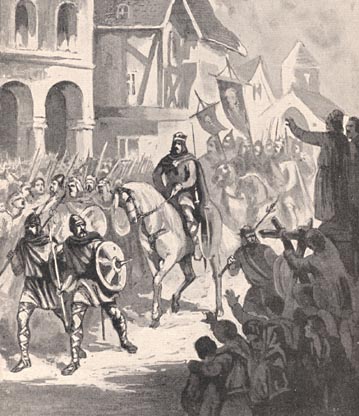Charles Martel
When Pépin
of Heristal died in 714, Charles Martel had to overcome opposition from
the family of Pépin's first wife Pletrude. By 718, Charles
had triumphed, gaining not only his father's office of Mayor of the Palace,
but also his father's fortune. He then vanquished other Frankish
leaders to greatly extend his realm. The Merovingian kings Childperic
II (reigned 715-721) and Theuderic IV (reigned 721-737) were mere
figureheads, and the Mayor of the Palace possessed supreme authority.
Following the death of King Theuderic IV in 737, Charles Martel ruled alone
as Mayor of the Palace. Although the throne was vacant, Charles did
not attempt to claim it.
Charles' most spectacular victory came
in 732 when he triumphed over an invading Islamic army from Spain at the
Battle of Poitiers, also called the Battle of Tours, and is regarded as
one of the most decisive battles in the history of the world. The
fighting began near Tours, France, and ended near Poitiers. Charles
was later called Martel, meaning "the Hammer", because of his victory over
the Muslims.
Charles Martel entering Paris after the defeat of
the Saracens
 |
The wave of Saracen conquest
flowed over the Pyrenees into Gaul, and for a time it appeared likely to
add that country to the empire of the caliphs. Fortunately for Europe,
Charles Martel, the ruler of the Franks, proved equal to the occasion,
and in a desperately hard-fought battle that began near Tours and ended
near Poitiers, defeated the Saracenic emir Abd-er-Kahman, and saved Europe
from the Moslem yoke.
It is worthy of notice that this
battle - emphatically one of the most decisive battles of the world - was
fought in 732, exactly 100 years after the death of Mohammed, the so-called
the "Prophet of God".
The Book of History, Vol VIII, pg. 3374
|
Edward Gibbon wrote that were it not
for Charles Martel that "Perhaps the interpretation of the Koran would
now be taught in the schools of Oxford, and her pulpits might demonstrate
. . . the sanctity and truth of the revelation of Mahomet. . . .
From such calamities was Christendom delivered by the genius and fortune
of one man." Edward Gibbon: History Of
The Decline And Fall Of The Roman Empire, Volume 5, page 156 -
157
In order to maintain his power, Charles
had to engage in continual struggles with various princes, both secular
and ecclesiastical. Following his victory at Poitiers in 732, he
attacked some unruly bishops including Eucherius of Orléans.
Because of this, his memory suffered. During the ninth century, his
tomb at the abbey of St. Denis is said to had been opened by the abbot,
and a hideous dragon supposedly emerged from a blackened, charred and otherwise
barren coffin; thus demonstrating Charles Martel's damnation for despoiling
the Church of its property. Later historians at St. Denis said he
had taken Church lands only temporarily and had intended eventually to
reimburse and further enrich the Church.
Click to return to the Charlemagne
Page or use your browser's back button.
Please visit the Sewell
Genealogy Site Map for other pages in this series.
This summary was written in July 2006 by Robert
Sewell using sources including the following:
World Book Millenium 2000 Deluxe Edition,
© 1999 World Book Inc., © IBM Corp.
Microsoft Encarta Encyclopædia 99,
© 1993-1998 Microsoft Corporation
Norman F. Cantor (ed.) The Encyclopædia of
the Middle Ages, New York, 1999
Berhard Grun, The Timetables of History,
New York, 1991
The Book of History (18 Volumes), London,
1914
The Kings of France, http://www.beyond.fr/history/kings.html
